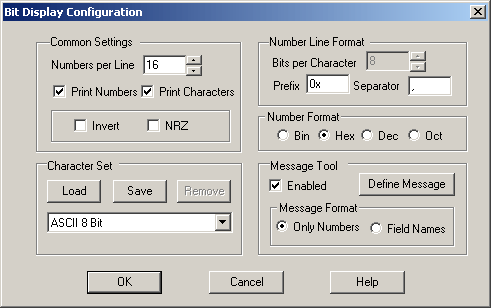BIT Analyzer Display Configuration
General description
This controls the output of the bit analyzer’s bit/character display. The bits can be printed in the desired format (binary, hexadecimal, decimal, octal). The characters can also be printed in several different formats (ASCII 7 bit, ASCII 7 bits and one parity bit, ASCII 8 bit, BAUDOT (ITA2), ITU 342-3 (ITA3), ITU 476-5 (SITOR), ARQ-E and BCD).
Configuration
Parameters
Numbers per line
This is the number of numbers in one line.
Print numbers
When this switch is active the numbers (in binary, hexadecimal, decimal or octal) will be printed on the display.
Print characters
When this switch is active the characters using the selected character set will be printed on the display.
Invert
When this switch is active the input bits will be inverted (0->1, 1->0).
NRZ
If the bit value changes state from the previous bit, the NRZ value is 1 otherwise it is zero.
Bits per character
This is the number of bits used in the character. For example in BAUDOT this value is 5.
Prefix
The characters printed before the number.
Separator
The characters printed between the numbers.
Number format
The used number format (binary, decimal, hexadecimal etc).
Only Numbers
If this is selected, the message field names are not printed into screen.
Field Names
If this is selected, the message field names are also printed into screen.
Character set
The character set used (ASCII 7 bit, ASCII 7+’1’ bit, ASCII 8 bit, BAUDOT (ITA2), ITU 342-3 (ITA3), ITU 476-5 (SITOR), ARQ-E and BCD).
There is also the capability to generate your own character sets as well as editing the existing ones. Save the character set to a file. This file can be opened with any text editor (for example with Notepad). The file format contains several fields:
Name
The name of the character set.
Bits per char
The number of bits per character.
Bit mask
The number of real bits in a character. For example in 7 bit ASCII where the parity bit is the MSB, the mask is 0x7f.
To letter chars
There are two different character sets in some codes like BAUDOT where there is a letter/figure control character). These characters will switch the used set to the primary set (letters).
To figure chars
These characters are will switch the used set to the secondary set (figures).
Characters
The characters will be shown in format ‘T 5 ; 1’, where ‘T’ is the character in the primary set and ‘5’ in the secondary set. ‘1’ is the value (00001) in comments. The characters must be in the order from the first character as binary (0x00) to the last character in the character set. The character set has 2n (where n = Bits per char) characters and every code must be defined i.e. in 5 bit Baudot 25 = 32
The Character Set is loaded from a file by pressing The ‘Load’ button. The default file extension for character set files are .chr. After loading the character set, it is visible in the drop-down menu.
The Character Set can be removed pressing the Remove button. The build in character sets are NOT removable.
Message Tool
With message tool it is possible to define messages which have different amount of fields. The width of different fields can be defined freely. If message tool is enabled pressing ‘Define Message’ button opens the Message Definition Dialog
Messages can be printed as two different formats. Only numbers format does not print message field names. Field names format prints fields into separate lines and also message field names
